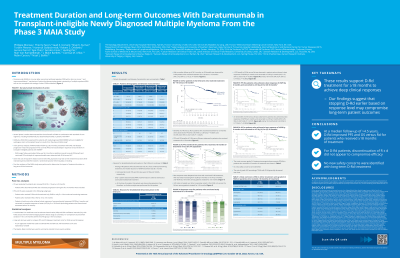Back

Industry Encore Posters
JL1038E: Treatment Duration and Long-term Outcomes With Daratumumab in Transplant-ineligible Newly Diagnosed Multiple Myeloma From the Phase 3 MAIA Study
Saturday, October 22, 2022
10:00 AM – 11:00 AM ET

- YH
Yi L. Hwa, DNP, APRN, CNP
Program Director of Hem/Onc Fellowship, Associate Professor of Medicine
Mayo Clinic College of Medicine and Science
Rochester, Minnesota, United States
Poster Presenter(s)
Introduction:
In the phase 3 MAIA study (NCT02252172), daratumumab plus lenalidomide and dexamethasone (D-Rd) treatment until progression improved progression-free survival (PFS) and overall survival (OS) versus lenalidomide and dexamethasone (Rd) alone in patients with transplant-ineligible newly diagnosed multiple myeloma. Given the cost of long-term disease control with D-Rd, physicians may look to limit treatment while maintaining clinical benefit. However, randomized practice-informing data are lacking.
Methods:
To determine the impact of treatment duration on long-term clinical outcomes, a post hoc analysis of OS was conducted based on D-Rd treatment duration ( < 18 vs ³18 months), excluding patients who discontinued therapy due to disease progression during the first 18 months. Post hoc analyses were also performed in D-Rd patients who discontinued only D or only R±d but continued remaining treatment to evaluate the impact of discontinuing individual D-Rd–regimen components. To assess the impact of treatment duration and response on PFS and OS, a post hoc analysis was conducted in patients who received D-Rd or Rd treatment for ³9 or ³18 months.
Results:
Median follow-up time was 56.2 months. OS benefit was observed in D-Rd patients who received treatment for ³18 versus < 18 months (HR, 0.16; 95% CI, 0.1-0.25; P< 0.0001). For D-Rd patients who discontinued R±d at any time but continued D±d treatment (n=48), 60-month PFS and OS rates were 97.9% and 100%, respectively, compared with 52.5% and 66.3% in the intent-to-treat population (n=368). PFS and OS benefits of D-Rd versus Rd were observed in patients who received treatment for ³18 months (PFS HR, 0.57; 95% CI, 0.43-0.76; P< 0.0001/OS HR, 0.68; 95% CI, 0.47-0.98; P=0.0379) and ³9 months (PFS HR, 0.49; 95% CI, 0.38-0.62; P< 0.0001/OS HR, 0.63; 95% CI, 0.47-0.85; P=0.0025). Among patients treated for ³18 months, responses with D-Rd deepened over time; complete response or better (³CR) rates increased from 9.2% by 6 months, to 19.1% by 9 months, to 49.8% by 18 months. For patients with treatment ³18 months, D-Rd significantly prolonged PFS and OS versus Rd in patients who achieved a best response of very good partial response by 6 months and deepened to ³CR by 9 months (PFS HR, 0.15; 95% CI, 0.05-0.45; P< 0.0001/OS HR, 0.25; 95% CI, 0.07-0.86; P=0.0175) or by 18 months (PFS HR, 0.34; 95% CI, 0.19-0.62; P=0.0002/OS HR, 0.33; 95% CI, 0.17-0.65; P=0.0006). No new safety concerns were identified, and grade 3/4 hematologic treatment-emergent adverse events with D-Rd generally decreased over time.
Conclusions:
At a median follow-up of >4.5 years, D-Rd improved clinical outcomes versus Rd in patients who received ³18 months of treatment. For D-Rd patients, discontinuation of R±d did not appear to compromise efficacy. Our findings support D-Rd treatment for at least 18 months to achieve deep clinical responses and that stopping D-Rd earlier based on response level may compromise long-term patient outcomes.
In the phase 3 MAIA study (NCT02252172), daratumumab plus lenalidomide and dexamethasone (D-Rd) treatment until progression improved progression-free survival (PFS) and overall survival (OS) versus lenalidomide and dexamethasone (Rd) alone in patients with transplant-ineligible newly diagnosed multiple myeloma. Given the cost of long-term disease control with D-Rd, physicians may look to limit treatment while maintaining clinical benefit. However, randomized practice-informing data are lacking.
Methods:
To determine the impact of treatment duration on long-term clinical outcomes, a post hoc analysis of OS was conducted based on D-Rd treatment duration ( < 18 vs ³18 months), excluding patients who discontinued therapy due to disease progression during the first 18 months. Post hoc analyses were also performed in D-Rd patients who discontinued only D or only R±d but continued remaining treatment to evaluate the impact of discontinuing individual D-Rd–regimen components. To assess the impact of treatment duration and response on PFS and OS, a post hoc analysis was conducted in patients who received D-Rd or Rd treatment for ³9 or ³18 months.
Results:
Median follow-up time was 56.2 months. OS benefit was observed in D-Rd patients who received treatment for ³18 versus < 18 months (HR, 0.16; 95% CI, 0.1-0.25; P< 0.0001). For D-Rd patients who discontinued R±d at any time but continued D±d treatment (n=48), 60-month PFS and OS rates were 97.9% and 100%, respectively, compared with 52.5% and 66.3% in the intent-to-treat population (n=368). PFS and OS benefits of D-Rd versus Rd were observed in patients who received treatment for ³18 months (PFS HR, 0.57; 95% CI, 0.43-0.76; P< 0.0001/OS HR, 0.68; 95% CI, 0.47-0.98; P=0.0379) and ³9 months (PFS HR, 0.49; 95% CI, 0.38-0.62; P< 0.0001/OS HR, 0.63; 95% CI, 0.47-0.85; P=0.0025). Among patients treated for ³18 months, responses with D-Rd deepened over time; complete response or better (³CR) rates increased from 9.2% by 6 months, to 19.1% by 9 months, to 49.8% by 18 months. For patients with treatment ³18 months, D-Rd significantly prolonged PFS and OS versus Rd in patients who achieved a best response of very good partial response by 6 months and deepened to ³CR by 9 months (PFS HR, 0.15; 95% CI, 0.05-0.45; P< 0.0001/OS HR, 0.25; 95% CI, 0.07-0.86; P=0.0175) or by 18 months (PFS HR, 0.34; 95% CI, 0.19-0.62; P=0.0002/OS HR, 0.33; 95% CI, 0.17-0.65; P=0.0006). No new safety concerns were identified, and grade 3/4 hematologic treatment-emergent adverse events with D-Rd generally decreased over time.
Conclusions:
At a median follow-up of >4.5 years, D-Rd improved clinical outcomes versus Rd in patients who received ³18 months of treatment. For D-Rd patients, discontinuation of R±d did not appear to compromise efficacy. Our findings support D-Rd treatment for at least 18 months to achieve deep clinical responses and that stopping D-Rd earlier based on response level may compromise long-term patient outcomes.

